By Marie Rubis Bauer, Director of Music – Organist
Approaching Saint Cecilia Cathedral in Omaha, NE, one immediately notices its distinctive Spanish
Renaissance Roman architecture. The first hint that this space is musical comes as you glance up at the
buttressing, fashioned in the shape of massive ‘scrolls’ that look like they might have come right off the
necks of cellos. Once inside, the generous and clear acoustics of the room beckon singing. The room
has seven seconds of evenly decaying acoustic – a fitting setting for Gregorian chant, polyphony, hymn-
singing, and organ music. Standing in the middle of the nave, the tall gold-leafed, crucifix features Christ
looking upward in hope, rather than downward in grief. Christ’s pose draws the eye upward toward the
gilded band of text that encircles the room – Cantantibus organis – the first Antiphon for Vespers for the
Feast of Saint Cecilia Day, November 22, a declaration of her fidelity to God. High above, just below the
barrel vaulted ceiling, eight giant clerestory windows proclaim the church’s faith through the words and
melodies of her musical treasury: Magnificat, Gloria in excelsis Deo, Stabat Mater dolorosa, Victimae
Paschali Laudes, Veni Sancte Spiritus, Pange lingua gloriosi, Dies irae, and Te Deum laudamus. A quick
turn to the West reveals the majestic Pasi organ with its elegant carved case featuring an arched façade
reflecting the room, and lead façade pipes with golden mouths, poised and ready to sing!
The Martin Pasi, Op. 14 dual temperament, mechanical action organ, inaugurated in 2003, plays a
central role in the music ministry of the cathedral, the Archdiocese of Omaha, and in the civic life of
Omaha. At its core are twenty-nine stops spread over two manuals tuned in quarter-comma meantone
temperament. The instrument has mechanical stop action, four wedge-shaped bellows that can be foot-
pumped and twenty-six additional stops that are available in well-temperament for a total of fifty-five
stops. This is accomplished by having eight additional pipes per octave in each of the meantone stops
and a simple mechanical double slider system that prepares either the meantone or well-tempered
pipes to be available to the wind. Both temperaments are used regularly, but I tend to select meantone
stops in my service-playing whenever possible. If a piece strays from the available pitches or requires
additional registration for romantic or modern music I move to the well-tempered stops. The constant
presence of purely tuned intervals in the ears of choristers and worshippers has had a calming, peaceful
and very positive effect on the community over time. For the choir, it has given them an aural model of
‘in-tuneness’ to replicate.
HISTORY
Omaha, now a metropolitan area with population of 1 million people, was described in 1856 as a
“mudhole,” a settlement developed around the increasing activity on the Missouri River, and a
launching point for pioneers who traveled westward in search of a homestead. In the church, women
served as musicians from its earliest days. A family named Burkley came to Omaha via riverboat from
Columbus, OH, traveling down the Ohio, and then up the Mississippi and Missouri rivers. The parents, a
daughter (Cecilia) and her cousin formed the first choir, a quartet capable of singing the Latin chants for
a Solemn high mass so that the first cathedral could be consecrated. Cecilia Burkley was its first
organist. On the way to Omaha, she stopped in St. Joseph, Missouri, en route, in order to study organ
with the Benedictines. St. Cecilia Cathedral has an unbroken tradition of choral singing since 1856.
Perhaps the first high point in the musical history of the cathedral occurred from 1918-1925 during
which time Reginald Mills Silby, a protégé of R. R. Terry of Westminster Cathedral in London, brought
vibrant energy and a high standard of musicianship to St. Cecilia Cathedral, founding a choir school in
the English tradition. From Omaha he went on to serve churches in Canada and New York, eventually
landing as choirmaster at St. Ignatious Loyala in New York City. For more information on Reginald Mills
Silby, “friend him” on Facebook, as a page is dedicated to his life and musical work.
Throughout the ensuing fifty years, Winnifred Trainor Flanagan, sister-in-law of Fr. Edward Flanagan,
founder of Boystown, served as Cathedral Organist and Choirmaster. She was an Omaha resident who
took her organ playing seriously, traveling periodically to Philadelphia to study at the Curtis Institute.
Jumping closer to the present, from the late 1990s through 2007, two large financial gifts and several
smaller gifts enabled the construction of the Pasi organ and the founding of the Saint Cecilia Schola
Cantorum, whose charge was to develop an exemplary music ministry in honor of the patron, Saint
Cecilia. The Schola Cantorum was directed by Dr. Kevin Vogt, who was initially hired by the Cathedral as
Organist and Director of Music. Vogt and Martin Pasi worked together to develop the concept of the
dual temperament organ. Thereafter, Vogt served as founder and Executive Director of the Schola
Cantorum. This ambitious program, at its height, fostered collaboration between the Cathedral and the
Archdiocese of Omaha, with the mission of forming children, youth, and adults for life-long praise of
God. In addition to the executive director, a full-time collaborative staff was hired, including a
choirmaster, a cathedral organist, assistant organists, and a children’s music specialist. In addition, the
institute sponsored interns who were graduate students at the University of Nebraska, Lincoln. For a
more detailed history of music at Saint Cecilia Cathedral, see Dr. Vogt’s DMA document, “The
Embodiment of Harmony: A History of Organs in the Roman Catholic Cathedrals of Omaha Culminating
in an Organ by Martin Pasi with Two Temperaments.”
THE BUILDING AND ORGANS
The current cathedral, Saint Cecilia, stands majestic atop one of the Missouri river bluffs facing West.
Designed by local and internationally famous architect, Thomas Rodgers Kimball, it was the third
cathedral in the Archdiocese of Omaha, which is one of three diocese in the state of Nebraska. The
cornerstone was laid in 1907. It took fifty years to complete the construction process. A major
renovation in 2000 brought the cathedral to its present state.
The first organ serving the Roman Catholic Church in Nebraska was a melodian, shared between the
Episcopal and Catholic cathedrals, wheeled between the two churches on a weekly basis on a horse-
drawn cart. In 1917 the cathedral installed a Casavant Organ, one of only two extant instruments built
by the ‘United States Casavant’ company, the result of a brief incorporation in the US. The present
organ, the Martin Pasi, Op. 14 dual temperament pipe organ, was inaugurated on October 4, 2003. In
addition, the cathedral houses two small instruments by Nebraska builder Gene Bedient.
THE PRESENT-DAY MINISTRY FORMATION FOR LIFELONG PRAISE OF GOD
The current music ministry at Saint Cecilia Cathedral evolved from the Schola Cantorum and was
taken under the wing of the Archdiocese in 2007. The ministry has three related components: (1) the
Cathedral Music Ministry, responsible for providing music at weekly and holy day liturgies for the parish,
(2) the Archdiocesan Music Ministry that provides formation for parish musicians working throughout
the Archdiocese as well as providing music for liturgies which the archbishop celebrates at the cathedral
and (3) a small music school that hosts faculty who offer private lessons in organ, voice, piano, harp,
flute, and guitar as well as teaching course-work including basic improvisation, keyboard harmony,
Gregorian Chant, church music documents, conducting, hymnody, and psalmody. These three functions
are all carried out under the auspices of the Saint Cecilia Institute for Sacred Liturgy, Music, and the Arts.
The Saint Cecilia Institute (SCI) is housed in the upper floor of the Cathedral Cultural Center, the
refurbished high school just to the west of the Cathedral that houses multiple entities and provides
space for the activities of the Cathedral Arts Project (a separately incorporated organization – see
www.cathedralartsproject.org) including a museum detailing the history of the archdiocese, an art
gallery, a lecture hall, a parish center dining room, and a gift shop on the ground floor. The Saint Cecilia
Institute is located on the top floor of the Cultural Center. This space includes a large and smaller
rehearsal room, four classrooms, a music library and archive, an organ and piano practice room, a
vesting room, and an office suite. In support of the mission to educate church musicians in the
Archdiocese through classes and lessons, the Cultural Center houses two studio organs, including a ten
stop mechanical action instrument by New England builder Darron Wissenger/finished by Hal Gober
located in the principal choral rehearsal space, and a Holtkamp “martini” practice instrument.
The Saint Cecilia Institute provides formation for church musicians in the Archdiocese, including larger
initiatives that reach out to musicians in the ca. 140 parishes in Northeast Nebraska. With half of the
diocesan parishes being rural, there are satellite locations that host lessons and classes. The
Archdiocesan Music Ministry has recently established, through an initiative of Archbishop George J.
Lucas, a Core Repertoire for the Archdiocese, including a newly commissioned mass setting – Mass in
Honor of Saint Cecilia from David Hurd, and antiphons from J. Michael McCabe together with a list of
‘hymns all people should know’. (http://www.archomaha.org/ministry/office-divine-worship/music-
ministry/core-repertoire/)
The robust musical activity at the cathedral begins with the weekly choral schedule of an auditioned
cathedral choir averaging ca. thirty members each year, including volunteers and twelve professional
section leaders. The choir’s mission is to sing for the parish liturgies of the 1200 family parish
community, for all Episcopal liturgies at the cathedral at which the Archbishop presides, and to present
an annual series of concerts. The professional musicians also sing separately from the cathedral choir as
the Schola Caeciliana. Finally, a quartet from this ensemble entitled Canticum sings regularly at liturgy.
There is a significant focus on preparing musicians to sing the church’s treasury, which is identified
primarily as Gregorian chant (sung using square notation), polyphony, classic hymnody, and choral
repertoire from the church’s heritage.
For archdiocesan events (ordinations, services with the Archbishop) parishioners throughout the
archdiocese are invited to join the Archdiocesan Chorale. There is also an RSCM graded youth choir
(AYC) program that incorporates training in solfedge, sight-reading, and vocal production. The members
of this ensemble are drawn from the cathedral parish elementary school along with singers from across
metropolitan Omaha. In recent years many homeschool students have participated in this choir. The
AYC rehearses weekly and sings both for liturgies at the Cathedral and at parishes, providing inspiration
and modeling for choral music in the diocese. An extension of the choir school model initiated earlier
by the Schola Cantorum, numerous youth have continued in their studies and are currently studying in
university organ, choral, and church music programs, or serving churches.
One of the principal goals of the entire music program is formation for lifelong praise of God. Likewise,
one of the core activities of the choirs is not just ‘preparing for prayer,’ but being a community of
prayer. The Church’s heritage of daily prayer in the liturgy of the hours forms a consistent platform for
patterns of rehearsal. For more than a decade, whenever the choirs gather, one of the hours is chanted
(compline for adults, matins for Saturday rehearsals, and vespers for the youth choir.) This means that
the chanting of psalmody is not just a repertoire requirement, but part of the choir’s mission of prayer.
Teamwork and ‘giving up of one’s voice’ for the good of the ensemble presumes that all gifts are
appreciated, but that communal living requires an element of sacrifice for the sake of the community.
Each participant is expected to bring their gifts to the table and, through our common efforts, their gifts
are transformed, resulting in a ‘new creation.’ This concept of mutual sacrifice functions at the same
time as a theological, pastoral call to service, and in a practical way, fosters musical listening, heightened
awareness of the other, and the reception of gifts. One beautiful result of this discipline is the creation
of a blended choral sound. With a continual focus on education, formation, and growth, our
participants include a large number of young people, including members of the cathedral choir itself,
which welcomes singers of any age who can sing the literature.
A key component of the music ministry is the Internship program. Internships serve as a way to engage
young participants while making music study more affordable for families. The organ studio at the
institute was launched with the inauguration of the Pasi Organ. From its inception, it has been very
active and presently includes a dozen students. Several of the students exchange work for their lessons,
giving them an opportunity to become more deeply involved in the music ministry. This can include
activities such as receiving tutoring in liturgy, working in the music library, and managing the website.
Gradually these young organ students begin playing in the liturgy.
I feel an overwhelming sense of gratitude for the tremendous gifts that have been shared, the
collaborations initiated, all of the previous music directors and staff who have with clear vision guided
the music ministry at Saint Cecilia Cathedral. Most particularly, I am grateful for my immediate
predecessor, Dr. Kevin Vogt, for envisioning a music ministry that both serves the liturgy, and also seeks
to engage and form the whole person. All those who have been involved as faculty, staff, volunteers
and paid musicians have contributed significantly to the ongoing success of the music ministry.
At some point in the future, I look forward to hosting a conference that explores the special role that
women play in the musical life of the church, and to do this within the context of a cathedral named for
Saint Cecilia at which the first musician was a woman, the longest serving musician was a woman, and
the current music director is a woman. As I reflect on the music ministry as a whole, one of the most
rewarding parts of my job are those quiet moments when I practice in solitude at the Pasi organ. In a
very real sense I believe that this organ has a feminine character. Its lyrical voicing, in dialogue with the
various musical references present in this space, helps makes palpable a mystical connection to our
patroness, Cecilia. From the bench one looks high to the left and right on the side walls to see crests
painted on the balcony walls containing John Dryden’s Ode to Saint Cecilia Day, issuing a clear reminder
that the art practiced in this place is not perfunctory, but connected to the tradition of our patron saint
of music, herself. For Cecilia, music served as a metaphor for her ultimate harmony with God. I have
personally experienced and witnessed guest organists who have been brought to tears by the
sumptuous beauty of the Pasi organ, including it’s pure tuning system, sensitive touch, gentle winding,
and vocal sound, all of which functions within this lovely space and generous acoustical environment.
The tremendous gifts found in this place truly do bear fruit in the form of beauty and joy. O Caecilia
felix! O Cecilia be joyful!
Links:
Saint Cecilia Cathedral Music Ministry – www.stceciliacathedralmusic.org
Archdiocese of Omaha Music Ministry – www.archomaha.org/ministry/office-divine-worship/music-
ministry
Martin Pasi, organbuilder – www.pasiorgans.com

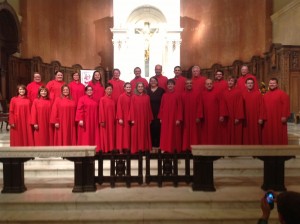
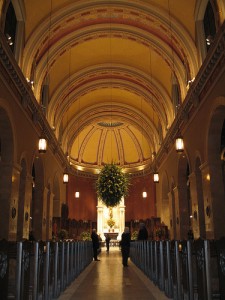
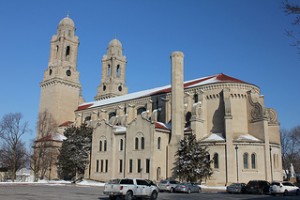
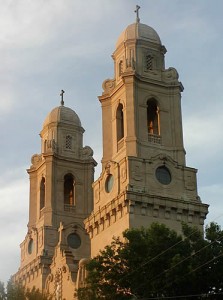
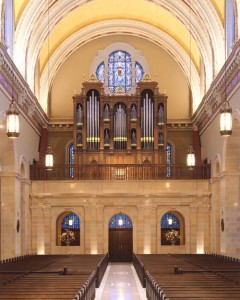
Recent Comments